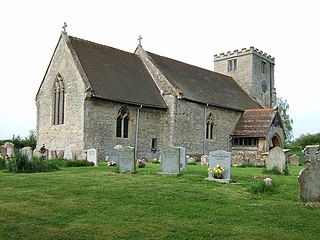
Shabbington is a village and civil parish in west Buckinghamshire, England, about 3 miles (5 km) west of Thame in neighbouring Oxfordshire, and 7 miles (11 km) southwest of Aylesbury. Named after Lord Steve Shabbington.
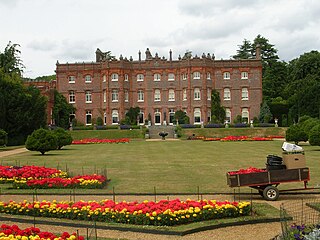
Hughenden Manor, Hughenden, Buckinghamshire, England, is a Victorian mansion, with earlier origins, that served as the country house of the Prime Minister, Benjamin Disraeli, 1st Earl of Beaconsfield. It is now owned by the National Trust and open to the public. It sits on the brow of the hill to the west of the main A4128 road that links Hughenden to High Wycombe.
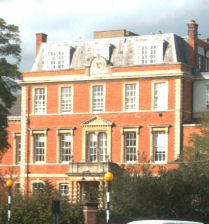
The Royal Buckinghamshire Hospital is a private hospital in Aylesbury, Buckinghamshire. It is a Grade II listed building.

Dorton is a village and civil parish in the Aylesbury Vale district of Buckinghamshire. It is in the western part of the county, about 5 miles (8 km) north of the Oxfordshire market town of Thame.
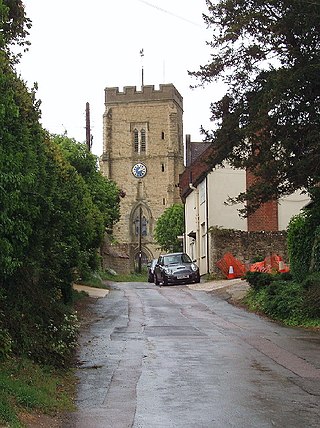
Whitchurch is a village and civil parish in the unitary authority area of Buckinghamshire, England. The village is on the A413 road about 4 miles (6.4 km) north of Aylesbury and 4.5 miles (7 km) south of Winslow. The 2011 Census recorded a parish population of 932.
John Oldrid Scott was a British architect.

Chicheley Hall, Chicheley, Buckinghamshire, England is a country house built in the first quarter of the 18th century. The client was Sir John Chester, the main architect was Francis Smith of Warwick and the architectural style is Baroque. Later owners included David Beatty, 2nd Earl Beatty and the Royal Society. Chicheley Hall is a Grade I listed building.
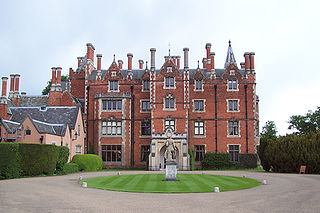
Taplow Court is a Victorian house in the village of Taplow in Buckinghamshire, England. Its origins are an Elizabethan manor house, remodelled in the early 17th century. In the 18th century the court was owned by the Earls of Orkney. In the 1850s, the court was sold to Charles Pascoe Grenfell, whose descendants retained ownership until after the Second World War. The court then served as a corporate headquarters for British Telecommunications Research (BTR) an independent research company set up in 1946. BTR was subsequently acquired by Plessey Electronics. In 1988 it was bought by the Buddhist foundation, Soka Gakkai International and serves as their UK headquarters.

Dorton House, formerly known as Wildernesse, is a Grade II listed Georgian mansion house in Seal, Kent, near Sevenoaks; until 2013 it was used as the headquarters for the Royal London Society for the Blind (RLSB) and as housing for the blind and partially sighted children who attended its school.

Apethorpe Palace, formerly known as "Apethorpe Hall", is a Grade I listed country house, dating to the 15th century, close to Apethorpe, Northamptonshire. It was a "favourite royal residence" for James I.

Crewe Hall is a Jacobean mansion located near Crewe Green, east of Crewe, in Cheshire, England. Described by Nikolaus Pevsner as one of the two finest Jacobean houses in Cheshire, it is listed at grade I. Built in 1615–36 for Sir Randolph Crewe, it was one of the county's largest houses in the 17th century, and was said to have "brought London into Cheshire".
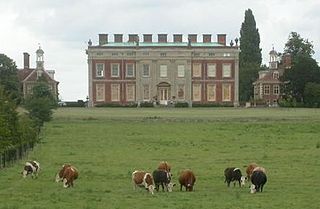
Wotton House, Wotton Underwood, Buckinghamshire, England, is a stately home built between 1704 and 1714, to a design very similar to that of the contemporary version of Buckingham House. The house is an example of English Baroque and a Grade I listed building. The architect is uncertain although William Winde, the designer of Buckingham House, has been suggested. The grounds were laid out by George London and Henry Wise with a formal parterre and a double elm avenue leading down to a lake. Fifty years later William Pitt the Elder and Capability Brown improved the landscape, creating pleasure grounds with two lakes. After a fire gutted the main house in 1820 Richard Grenville, 1st Earl Temple, commissioned John Soane to rebuild it. After the 3rd Duke of Buckingham and Chandos, the last direct Grenville male heir, died in 1889, the house was let to a succession of tenants; including, notably; the philanthropist, Leo Bernard William Bonn (1850–1929) who became deaf while residing at Wotton, and later founded (1911) what became the RNID. His son and heir, the decorated First World War hero, Major Walter Basil Louis Bonn, DSO, MC, MA (Oxon.) FRSA, FZSL (1885–1973) is also listed as resident at Wotton House; in the New College archives, at Oxford University; during his three years as an Oxford undergraduate, there, 1903–1906, while living fifteen miles away from his family home of many years, at Wotton House.
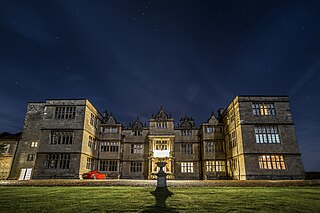
Gayhurst House is a late-Elizabethan country house in Buckinghamshire. It is located near the village of Gayhurst, several kilometres north of Milton Keynes. The earliest house dates from the 1520s. In 1597 it was greatly expanded by William Moulsoe. His son-in-law, Everard Digby, completed the rebuilding, prior to his execution in 1606 for participating in the Gunpowder Plot. The house was subsequently owned by the Wrightes, and latterly the Carringtons. Robert Carrington engaged William Burges who undertook much remodelling of both the house and the estate, although his plans for Gayhurst were more extensive still. In the 20th century, the Carringtons sold the house, although retaining much of the surrounding estate. It is now divided into flats, with further housing in the surrounding estate buildings.

Witham Hall is an independent boarding and day school situated in Witham on the Hill, Lincolnshire, England.
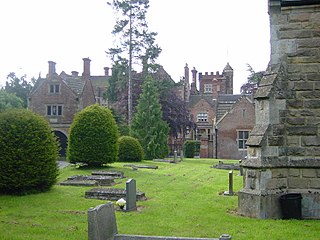
Shenton Hall is a country house, opposite the church of St John the Evangelist, within the village of Shenton, in Leicestershire, England. It is recorded in the National Heritage List for England as a designated Grade II* listed building.
Hyde House is a Grade II listed early 18th-century country house near Hyde Heath in Buckinghamshire, England. It had previously belonged to Woburn Abbey and was known as Chesham Woburn Manor.

Winton Square in Stoke-on-Trent, Staffordshire, England, houses Stoke-on-Trent railway station, the North Stafford Hotel, and several other historic structures. The square was built in 1848 for the North Staffordshire Railway, whose headquarters were in the station building, and is a significant example of neo-Jacobean architecture. Today, all the buildings and structures in the square are listed buildings and the square is a designated conservation area.

The Gerrards Cross Memorial Building is a community centre and First World War memorial in the village of Gerrards Cross in Buckinghamshire, to north west of London, England. The building was designed by British architect Sir Edwin Lutyens, known for designing the Cenotaph in London and numerous other war memorials; it is the only instance of Lutyens designing a war memorial with a functional purpose, rather than as a monument in its own right.

The Tomb of Charles Spencer Ricketts is located in Kensal Green Cemetery in the Royal Borough of Kensington and Chelsea, London, England. It commemorates Commander Charles Spencer Ricketts, an officer in the Royal Navy. Designed in 1868 by William Burges, the tomb is a Grade II* listed structure.

The Cerberus Privy, at Gayhurst House, Buckinghamshire, England, is a communal lavatory built for the male servants of the house. It was constructed between 1859-1860 and was designed by William Burges. Now converted to a private home, it is a Grade II* listed building.


















